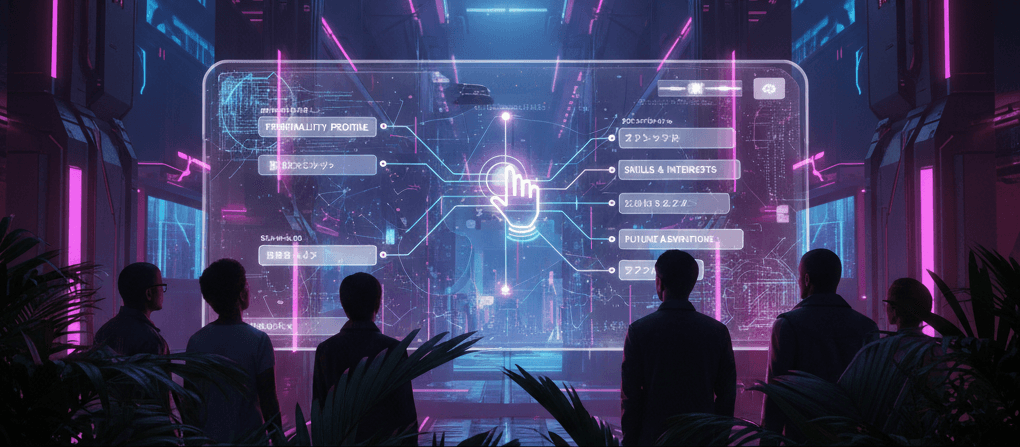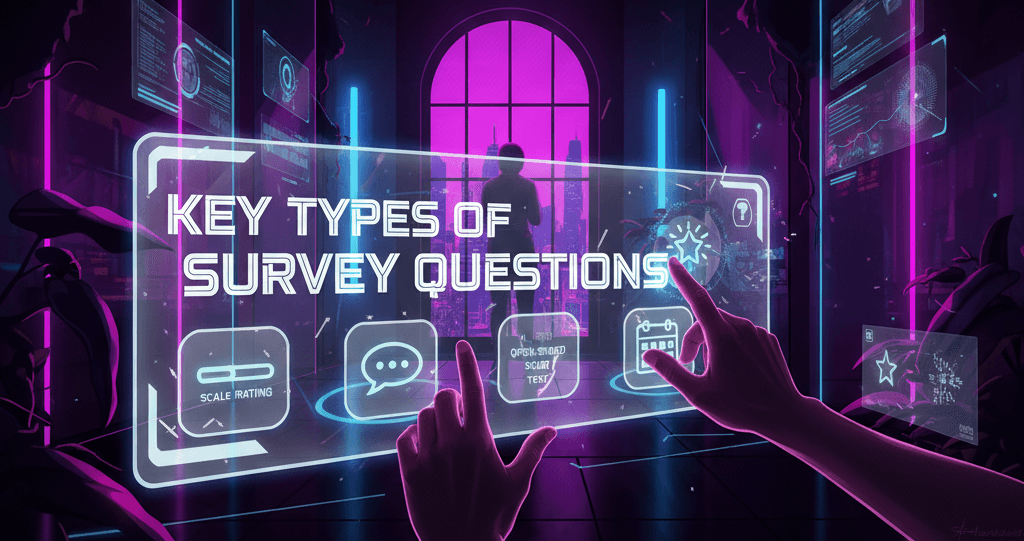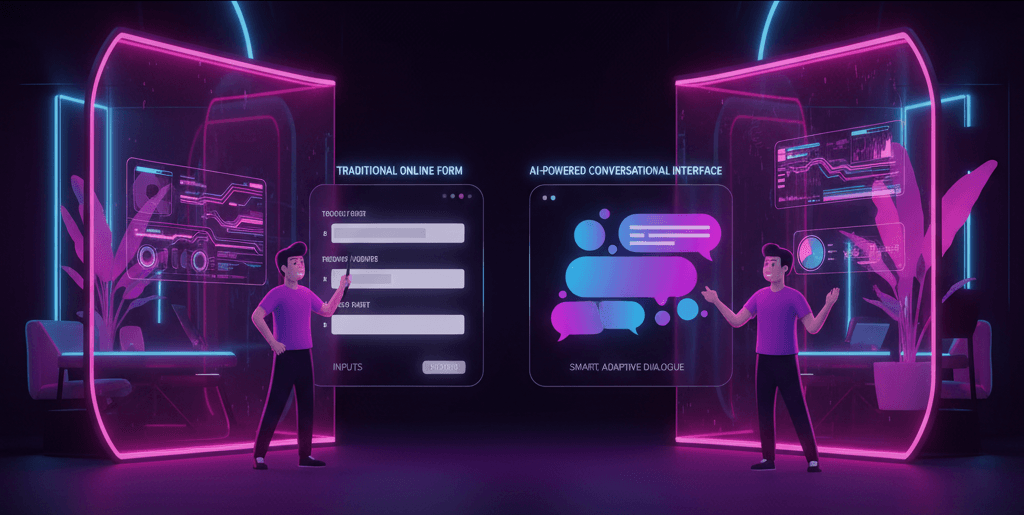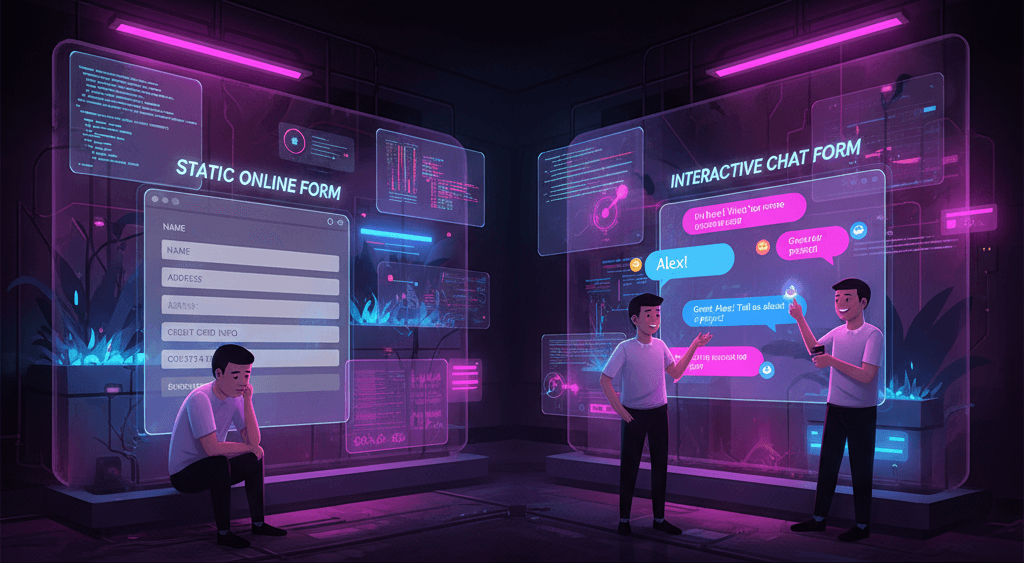Nowadays, users expect experiences that are not only functional but also intuitive and human-centric. Traditional web forms have long been the default for gathering information online, but they often fall short in delivering engaging and seamless interactions.
As attention spans shrink and competition for user engagement increases, businesses are turning to a more dynamic and user-friendly approach, conversational forms.
These forms transform the rigid, impersonal questionnaire into an engaging dialogue that mirrors real-life conversation, significantly improving user experience and conversion rates
Traditional vs. Conversational Forms
Traditional forms are structured, static, and often uninspiring. They typically present a long list of fields on a single page, leading users to feel overwhelmed or disengaged.
Think of the standard contact form with name, email, subject, and message boxes, efficient but forgettable.
Conversational forms, on the other hand, take a dynamic approach. They mimic natural dialogue by asking one question at a time and often use smart branching logic.
The experience feels more human, interactive, and less like filling out paperwork. Users feel they are being engaged in a real-time conversation, which improves completion rates significantly.
Modern tools like Zinq AI take this a step further by blending cutting-edge AI with design sensibilities to create not just functional forms, but emotionally engaging data collection experiences. With Zinq, a form becomes more than a list of questions, it becomes a conversation.
Psychology of Conversational Interactions
Humans are wired for conversation. Dialogue fosters trust and encourages sharing. A well-designed conversational form leverages this psychology to put users at ease, reduce friction, and guide them toward completion.
Key psychological drivers that conversational forms tap into include:
- Micro-commitments: Asking one question at a time makes users feel like the task is easy and manageable.
- Personalization: Responding based on previous answers builds a sense of interaction and relevance.
- Visual flow: Clean, interactive layouts reduce cognitive load and improve user satisfaction.
Zinq AI enhances this psychological connection by allowing you to tweak the AI’s tone to match your brand voice, whether professional, casual, or playful. This helps forms feel more natural and relatable.
Designing the Conversation Flow
Designing a conversational form is about mapping a conversation, not building a questionnaire. You need to think through the user’s journey from start to finish. Each question should logically follow the previous one, with a clear narrative or emotional arc.
Here are a few key steps:
- Start with a friendly greeting or purpose statement.
- Ask easy, low-pressure questions first.
- Use conditional logic to show only relevant questions.
- End with a “thank you” and a clear next step.
Zinq AI simplifies this process with its three-step workflow: Prompt, Design, and Publish.
You can begin with just a few phrases, and Zinq intelligently transforms them into a flow of questions with branching logic. Its intuitive interface makes it easy to refine the conversation and preview the experience before going live.
Question Framing and Branching Logic
How you ask a question matters just as much as what you’re asking. Good framing makes questions clear, concise, and engaging.
For instance, instead of asking, “What is your email address?” you could say, “Where should we send your confirmation?”
Branching logic makes the form feel intelligent. If a user selects “Yes” to attending an event, follow up with “Great! Would you prefer a morning or afternoon session?”
If they choose “No,” offer to send a recording or thank them and end the form.
Zinq AI’s AI-powered branching logic allows creators to build forms that adapt in real-time. You don’t need to manually configure every path, the platform intuitively recognizes patterns and provides branching suggestions that feel conversational and personalized.
Response Handling Techniques
How you respond to user inputs makes a big difference. Generic acknowledgments can feel cold or robotic, while thoughtful, dynamic responses make users feel heard.
Some effective techniques include:
- Echoing responses: “Thanks, Alex! Got it.”
- Offering tailored follow-ups: “Since you’re interested in design, here are a few templates you might like.”
- Adding progress indicators or conversational breaks to reduce fatigue.
With Zinq AI, form responses are visually engaging and dynamically structured. You can customize how each step looks and sounds, giving users a delightfully human experience.
And since the platform supports both conversational and classic form modes, it adapts to your audience’s preferences.
Testing and Optimization Methods
Even the most elegant form needs testing. A/B testing allows you to experiment with different versions of questions, tone, button placements, and response flows.
Some optimization tips:
- Track drop-off points.
- Optimize mobile responsiveness.
- Use analytics to see which questions create friction.
- Reframe or reorder questions based on behavior.
Zinq AI makes this easier by enabling quick edits, live previews, and instant publishing. Its smart editor allows you to test tone, branching paths, and even swap out templates to see what works best. The time from ideation to live testing is drastically reduced, helping teams iterate faster.
Successful Implementation Examples
Let’s explore some real-world examples of how conversational forms increase engagement and conversions.
Example 1: Job Application Form
A digital marketing agency switched from a traditional job form to a conversational one built with Zinq AI. The result? A 35% increase in completed applications and a 20% improvement in applicant quality.
By making the process feel like a conversation, applicants felt more motivated to finish and provide thoughtful answers.
Example 2: Webinar Registration
A SaaS startup used Zinq AI’s Webinar Registration template, tweaking the tone to match their brand.
Instead of a dull form, users were greeted with a lively back-and-forth that built excitement about the event. Registrations doubled, and feedback from attendees praised the “fun and fast” sign-up experience.
Example 3: Customer Feedback Survey
A retail brand used the Customer Satisfaction template from Zinq AI and saw a 40% jump in response rates. Customers found the survey experience “refreshing” and “surprisingly human.”
The team also used branching logic to dive deeper into negative reviews without frustrating users.
These cases show how the blend of AI, intuitive design, and emotional intelligence in Zinq leads to meaningful data collection without sacrificing user experience.
Why Choose Zinq AI for Conversational Forms?
Zinq isn’t just another form tool, it’s a design philosophy. It’s about doing more with less. Whether you’re creating feedback surveys, lead generation forms, event registrations, or internal polls, Zinq helps you:
- Capture attention with beautifully crafted, AI-powered forms.
- Build trust by making forms feel human and natural.
- Save time with ready-to-use templates and intelligent form generation.
- Customize tone and logic to make every interaction feel unique.
From its lifetime deal at $99 to the free starter tier, Zinq is built for creators, marketers, HR professionals, and product teams who want more out of their forms.
Want to try ZinQ AI? Start HERE
Final Thoughts
Conversational forms are more than a trend, they’re the future of online interaction. They reduce friction, boost engagement, and foster meaningful connections. But great conversations don’t just happen, they’re designed.
With tools like Zinq AI, creating forms that convert is no longer a heavy lift. It’s fast, intuitive, and fun. Whether you’re collecting emails, feedback, or applications, now’s the time to switch from static to smart, and from robotic to real.
Ready to transform your forms?
Get started with Zinq AI for free and create something worth responding to.












